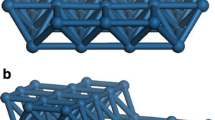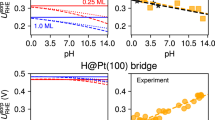Abstract
We present a comparative analysis of molecular dynamics trajectory studies of the influence of surface charge, ion strength, and ion adsorption on the interfacial water structure and the possible pathways of proton transport and discharge on negatively charged platinum(111) electrodes. The model used is a reactive force field based on a nine-state empirical valence bond model. It incorporates both proton transfer between water molecules and simultaneous electron and proton transfer to the metal (discharge). The interfacial water polarization is the result of the competition between the electrical field influence of the smooth surface charge and the point-like local charges of adsorbed positive or negative ions, which leads to variations of the prevalent proton discharge pathways depending on system composition.

In trajectory calculations of proton adsorption and discharge from aqueous solutions onto charged platinum electrodes, the presence of electrolytes in the adsorbate layer influences proton discharge mechanisms via changes in water orientation and via exclusion of discharge sites through repulsive cation-proton interactions.






Similar content being viewed by others
References
J. Tafel, Zeitschrift für physikalische Chemie. 50, 641–712 (1905)
K.D. Kreuer, S.J. Paddison, E. Spohr, M. Schuster, Chem. Rev. 104, 4637–4678 (2004)
M. Eikerling, A.A. Kornyshev, E. Spohr, in Proton-Conducting Polymer Electrolyte Membranes: Water and Structure in Charge. in Fuel Cells; Advances in Polymer Science, ed. by G. Scherer (Springer, Berlin, Heidelberg, 2008), pp. 15–54
N. Agmon, J. Phys. Chem. A. 109, 13–35 (2005). doi:10.1021/jp047465m
G.A. Voth, Acc. Chem. Res. 39, 143–150 (2006). doi:10.1021/ar0402098
D. Marx, Chem. Phys. Chem. 7(9), 1848–1870 (2006). doi:10.1002/cphc.200600128
D. Marx, A. Chandra, M.E. Tuckerman, Chem. Rev. 110, 2174–2216 (2010). doi:10.1021/cr900233f
T.C.J.D. von Grotthuss, Ann. Chim. LVIII, 54–74 (1806)
K. Tonigold, A. Groß, J. Comb. Chem. 33, 695–701 (2012). doi:10.1002/jcc.22900
T. Roman, A. Groß, Catal. Today. 202, 183–190 (2013). doi:10.1016/j.cattod.2012.06.001
T. Roman, A. Gross, Phys. Rev. Lett. 110, 156804 (2013)
S. Sakong, K. Forster-Tonigold, A. Gross, J. Chem. Phys. 144, 194701 (2016)
J. Cheng, J. VandeVondele, M. Sprik, J. Phys. Chem. C. 118, 5437–5444 (2014). doi:10.1021/jp500769q
R.V. Mom, J. Cheng, M.T.M. Koper, M. Sprik, J. Phys. Chem. C. 118, 4095–4102 (2014). doi:10.1021/jp409373c
J. Blumberger, K.P. McKenna, Phys. Chem. Chem. Phys. 15, 2184 (2013). doi:10.1039/c2cp42537h
K.P. McKenna, J. Blumberger, Phys. Rev. B. 86, 245110 (2012). doi:10.1103/PhysRevB.86.245110
M.-T. Nguyen, S. Piccinin, N. Seriani, R. Gebauer, ACS Catal. 5, 715–721 (2015). doi:10.1021/cs5017326
M. Otani, O. Sugino, Phys. Rev. B. 73, 115407 (2006). doi:10.1103/PhysRevB.73.115407
G.S. Karlberg, T.F. Jaramillo, E. Skulason, J. Rossmeisl, T. Bligaard, J.K. Norskov, Phys. Rev. Lett. 99, 126161 (2007). doi:10.1103/PhysRevLett.99.126101
J. Rossmeisl, E. Skúlason, M.E. Björketun, V. Tripkovich, J.K. Nrskov, Chem. Phys. Lett. 466, 68–71 (2008). doi:10.1016/j.cplett.2008.10.024
C.D. Taylor, S.A. Wasileski, J.-S. Filhol, M. Neurock, Phys. Rev. B. 73, 165402 (2006)
J.-S. Filhol, M. Neurock, Angew. Chem. Int. Ed. 45, 402–406 (2006)
Y.-H. Fang, G.-F. Wei, Z. Liu, Catal. Today. 202, 98–104 (2013)
E. Santos, P. Quaino, W. Schmickler, Phys. Chem. Chem. Phys. 14(32), 11224–33 (2012). doi:10.1039/c2cp40717e
M. Otani, I. Hamada, O. Sugino, Y. Morikawa, Y. Okamoto, T. Ikeshoji, J. Phys. Soc. Jpn. 77, 024802 (2008). doi:10.1143/JPSJ.77.024802
M. Otani, I. Hamada, O. Sugino, Y. Morikawa, Y. Okamotode, T. Ikeshojiae, Phys. Chem. Chem. Phys. 10, 3609–3612 (2008). doi:10.1039/b803541e
T. Ikeshoji, M. Otani, I. Hamada, Y. Okamoto, PCCP. 13, 20223–20227 (2011)
T. Ikeshoji, M. Otani, I. Hamada, O. Sugino, Y. Morikawa, Y. Okamoto, Y. Qian, I. Yagi, AIP Adv. 2, 032182 (2012). doi:10.1063/1.4756035
F. Wilhelm, W. Schmickler, R.R. Nazmutdinov, E. Spohr, J. Phys. Chem. C. 112, 10814–10826 (2008)
F. Wilhelm, W. Schmickler, R. Nazmutdinov, E. Spohr, Electrochim. Acta. 56, 10632–10644 (2011)
F. Wilhelm, W. Schmickler, E. Spohr, J. Phys. Condens. Matter. 22, 175001 (2010)
J. Wiebe, E. Spohr, Beilstein J., Nantotech. 5, 973–982 (2014). doi:10.3762/bjnano.5.111
J. Wiebe, K. Kravchenko, E. Spohr, Surf. Sci. 631, 35–41 (2015). doi:10.1016/j.susc.2014.06.016
S. Walbran, A.A. Kornyshev, J. Chem. Phys. 114, 10039–10048 (2001)
K. Heinzinger, P. Bopp, G. Jancsó, Acta Chir. Hung. 121, 27–53 (1985)
N. Garcia-Araez, V. Climent, E. Herrero, J. Feliu, J. Lipkowski, J. Electroanal. Chem. 576(1), 33–41 (2005). doi:10.1016/j.jelechem.2004.10.003
F. Gossenberger, T. Roman, A. Groß, Electrochim. Acta. 216, 152–159 (2016). doi:10.1016/j.electacta.2016.08.117
Acknowledgements
This work was performed with financial support by DFG within the framework of the DFG Research Unit 1376 “Elementary reaction steps in electrocatalysis: Theory meets Experiment,” for which we thank the DFG. ES is also grateful for support by the Cluster of Excellence RESOLV (EXC1069) funded by the Deutsche Forschungsgemeinschaft. Computations were in part performed at the UDE Cray computer operated by CCSS and ZIM.
Author information
Authors and Affiliations
Corresponding authors
Rights and permissions
About this article
Cite this article
Wiebe, J., Spohr, E. Water Structure and Mechanisms of Proton Discharge on Platinum Electrodes: Empirical Valence Bond Molecular Dynamics Trajectory Studies. Electrocatalysis 8, 637–646 (2017). https://doi.org/10.1007/s12678-017-0398-2
Published:
Issue Date:
DOI: https://doi.org/10.1007/s12678-017-0398-2




